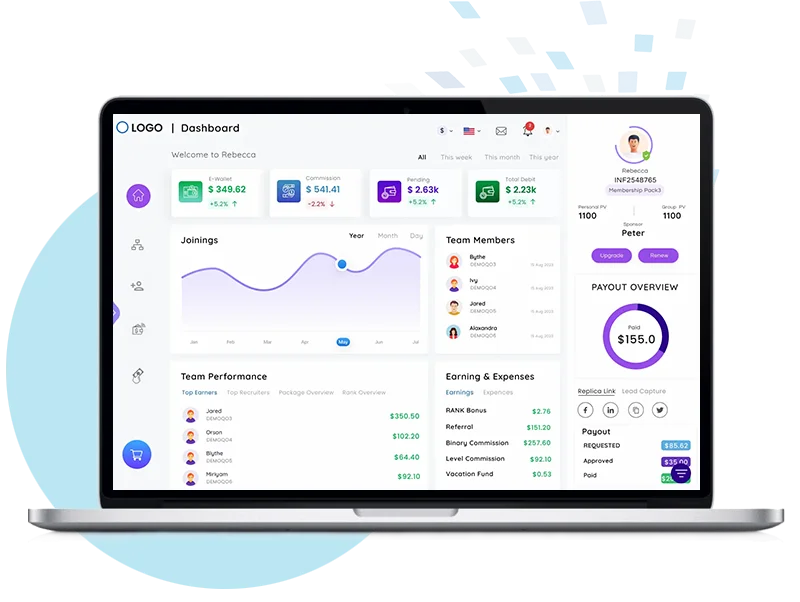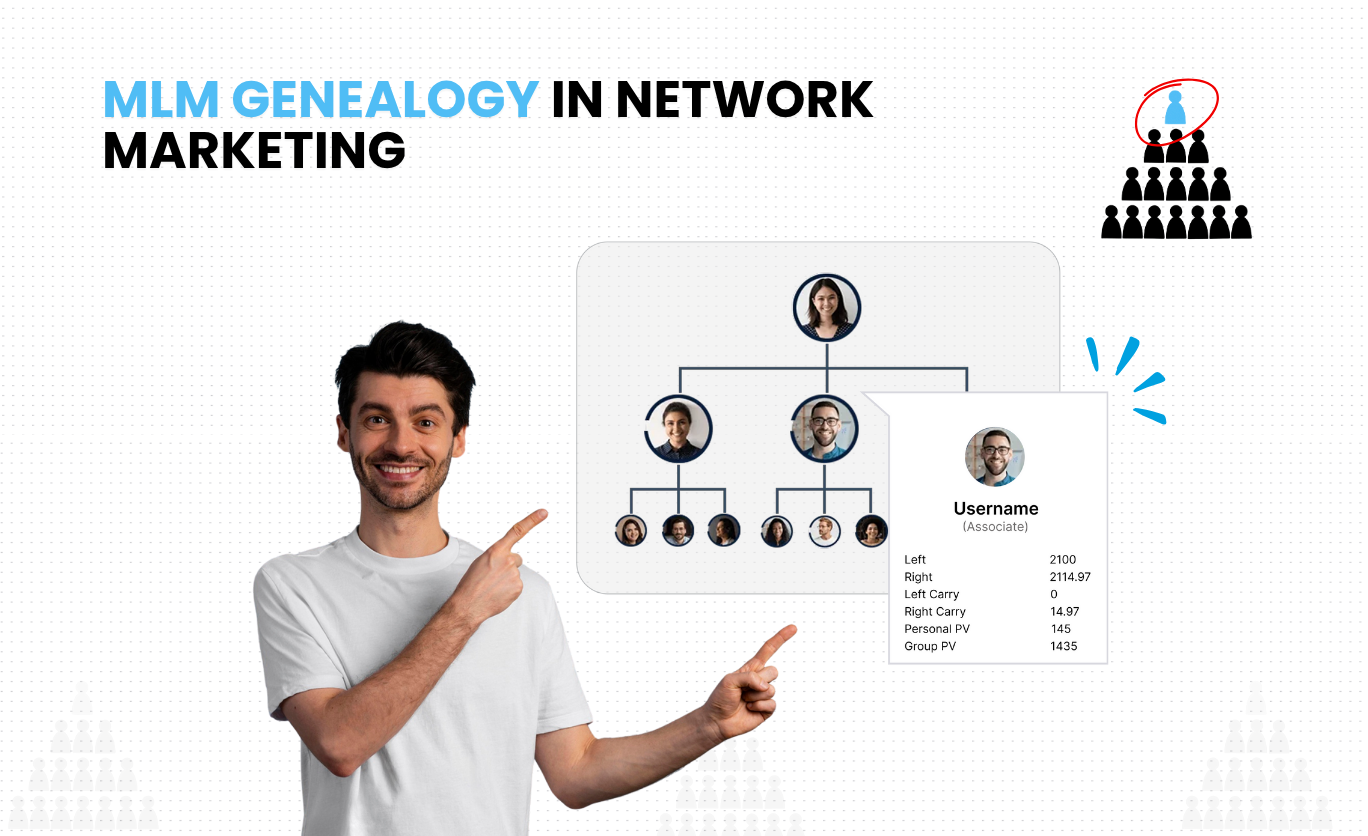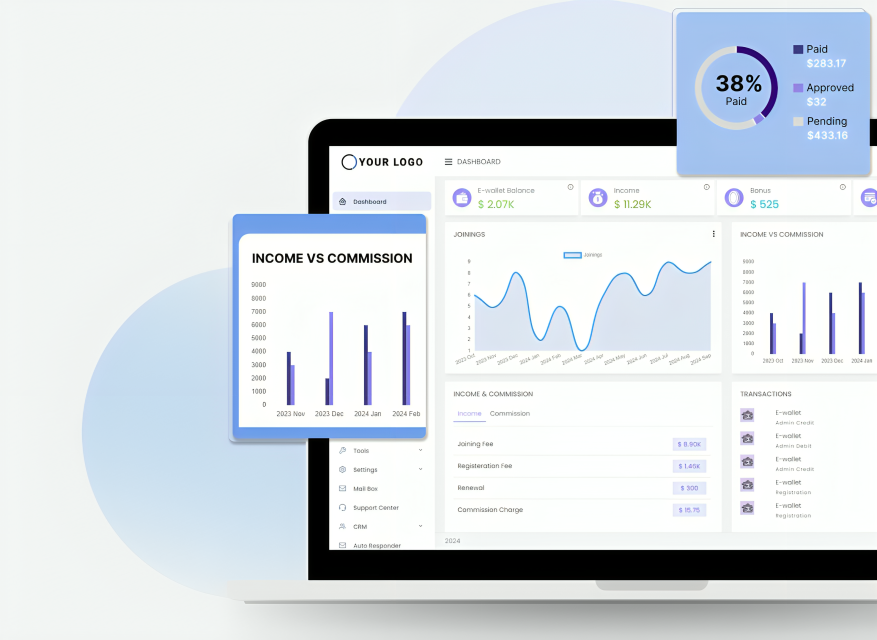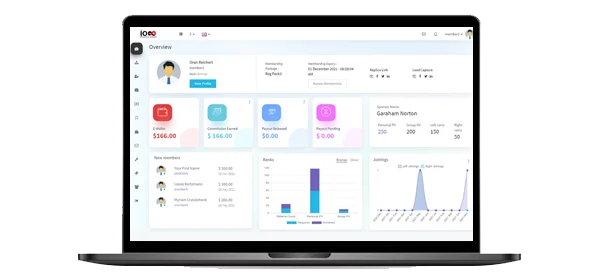In the world of network marketing, genealogy plays a very important role in tracking team growth, sales performance and commissions. An MLM genealogy tree offers a visual representation of how distributors are connected within a network, helping both individual team members and companies manage ranks, bonuses and overall business performance.
This guide provides a complete breakdown of MLM genealogy in network marketing, exploring its benefits, key components and how MLM software can simplify its management for growth and success in network marketing.
What is Genealogy in Network Marketing?
Genealogy in MLM is a visual organizational tool that maps out the hierarchical structure of a distributor network in the form of a tree diagram. It displays how each distributor is connected within the organization, starting from the top sponsor and branching downward to all recruited members.
The genealogy tree not only shows who sponsored whom, but also includes a complete record of each distributor’s performance, such as sales volume, recruitment activity, rank status, and commission eligibility.
This structure helps both distributors and company administrators track team growth, identify key performers, manage placement strategies, and calculate earnings accurately based on the company’s compensation plan.
The Purpose of an MLM Genealogy
MLM genealogy serves as a visual and organizational tool that outlines how all sales representatives are connected within the company.
Its primary purpose is to track the recruitment and sponsorship relationships between members showing who sponsored whom, and how downlines are built over time.
For individual distributors, MLM genealogy helps them manage and monitor their team’s growth, understand where their earnings are coming from, and identify key performers or areas that need more support.
For companies, MLM genealogy enables accurate calculation of overrides and bonuses by mapping out the exact upline who should be compensated for each sale. It also ensures that commission structures are applied correctly, according to the company’s compensation plan.
What is a Genealogy Tree in MLM
An MLM genelogy tree is a detailed visual chart that outlines an MLM organization’s structure, placing the business administrator at the top, followed by leaders and distributors arranged in a hierarchical, tree-like format beneath them.
Benefits of MLM Genealogy Tree in Your Network Marketing Business
An MLM genealogy tree provides the following valuable benefits for your business:
Clear Organizational Structure
The MLM genealogy tree provides a visual layout of how distributors are connected, helping you easily understand your team’s structure from upline to downline.
-
Visualizes the full distributor network from upline to downline for easy team structure understanding.
-
New joiner information from your referrals and downline is centralized and regularly updated.
Smooth Team Communication and Collaboration
The MLM genealogy tree feature makes it easy to reach out to your fellow distributors and collaborate with your downline team.
-
Enables direct communication across your network, from uplines to downlines.
-
Supports smooth collaboration with your team for improved performance and coordination.
Simplified Team Management
MLM genealogy tree allows leaders to monitor their downline’s performance, activity levels and growth, making it easier to provide support, training and motivation where needed.
-
Enables communication across uplines and downlines, helping monitor team progression.
-
Real-time updates provide centralized access to distributor data, new joiners, and key performance metrics like sales.
Commission Tracking
The Genealogy MLM tree helps identify who earns from each sale based on placement in the structure, ensuring accurate calculation of commissions and bonuses.
-
Tracks uplines and downlines to accurately calculate commissions based on each member’s position and contribution within the network.
-
Automates bonus eligibility by evaluating team performance and sales volume in real-time, simplifying the reward process.
Strategic Planning and Growth
By analyzing the MLM genealogy tree, you can pinpoint strong performers, identify inactive legs, and plan where to focus recruitment or development efforts to maximize business growth.
-
A lineage tracker provides easy access to sales figures and recruit counts, enabling smooth performance analysis.
-
Insights from performance metrics and member behavior help identify top performers and reward them accordingly.
Rank Advancement Visibility
It shows which team members are close to achieving new ranks, helping leaders guide and support them to meet qualification requirements.
-
The genealogy tree helps distributors set realistic goals by offering visibility into team structures and performance across the network.
-
Open access to peer performance allows teams to benchmark achievements and stay motivated toward clear, attainable targets.
Better Duplication and Training
With a clear view of how teams are developing, leaders can ensure consistent duplication of systems and good training across all levels of their organization.
-
The network marketing family tree organizes downlines hierarchically, making it easier to identify team members and track their sales and recruitment progress.
-
This structure supports efficient team management by enabling timely interventions, training, and support for underperforming members.
Historical Reference
The tree acts as a historical record of your network’s development, allowing you to review when and where growth occurred over time.
-
Helps identify key growth phases and successful recruitment periods, allowing you to analyze what strategies worked best during those times for better future planning.
-
Enables recognition of recurring patterns in network expansion, so you can replicate high-performing tactics and avoid past mistakes for sustained growth.
Let the MLM genealogy software handle placements, updates and genealogy tree building so you can focus on leading and growing.
What Details are Included in an MLM Genealogy Tree?
An MLM genealogy tree shows the following details:
1. Distributor Information
Name or ID of each distributor
Join date (enrollment date)
Sponsor/upline details (who recruited them)
Current rank or level in the compensation plan
Contact information (in some internal systems)
2. Placement Information
Upline/Sponsor Details
Placement Leg (e.g., left/right in binary, levels in unilevel, etc.)
Tree Level (how many levels deep in the structure)
3. Performance Metrics: Team Volume and Sales Data
Personal Sales Volume (PSV): Sales made by the distributor.
Group Volume (GV) or Team Volume (TV): Sales generated by the distributor and their downline.
Qualifying Volume (QV): Used to determine rank or bonuses.
4. Commission Tracking
Eligible Commissions
Pending/Released Payments
Bonuses Earned
Level-wise Commission Breakdown
5. Rank Progress and Status
Current rank and progress toward the next rank
Bonus or commission eligibility
Activity status (active, inactive, or pending)
6. Downline Details
Total downline size
Growth trends (e.g., new members added recently)
Number of personally sponsored recruits
Tree Navigation & Visualization Tools
Expandable/Collapsible Tree Nodes
Search & Filter Options
Graphical View of Hierarchy
Drag-and-Drop (for admin re-placement)
8. Binary/Matrix/Unilevel Specific Data (based on plan)
Left/Right Leg Volume (Binary)
Matrix Slot Fill Status
Depth & Width Count (Unilevel)
Types of MLM Genealogy Trees and How They Grow
In multi-level marketing, the genealogy tree is the visual representation of how distributors are placed in the organization based on the company’s compensation structure. Different MLM models use different types of genealogy trees, which influence team growth, earning potential and placement strategy.
Binary Genealogy Tree
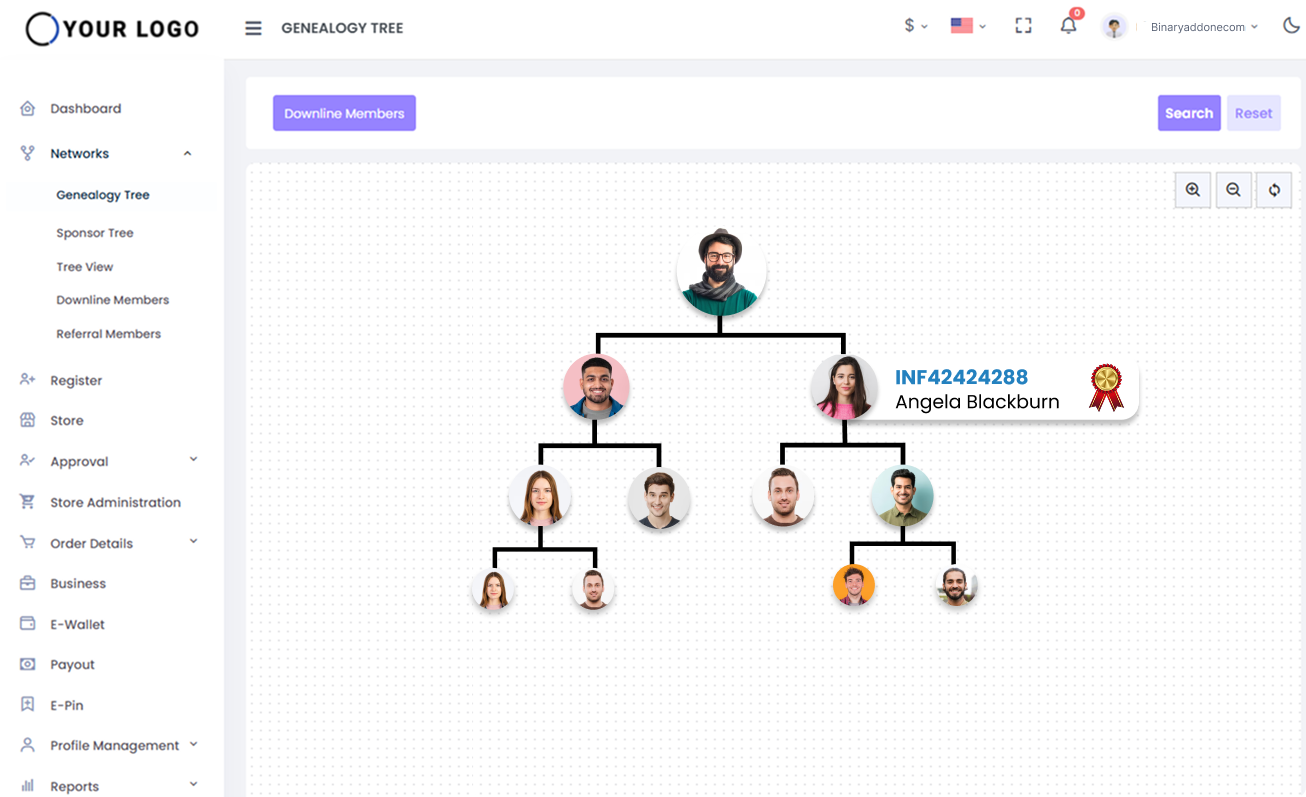
The binary genealogy tree structure consists of two legs, commonly referred to as the left and right legs. In this model, each distributor can sponsor only two people directly. Any additional recruits beyond those two are automatically placed deeper in the downline, often creating what is known as “spillover.”
The binary plan is popular for its simplicity and team-focused growth model. Commissions in a binary plan are calculated by pairing the sales volume from the weaker leg (the leg with less volume) with an equal amount from the stronger leg, and paying a percentage of that matched volume as a commission. This encourages balanced growth on both sides of the team.
Commission processing and binary MLM genealogy management are automated using Binary MLM Software. This software automatically matches sales volumes between the two legs of the binary tree while also maintaining real-time updates of the genealogy structure.
Unilevel Genealogy Tree
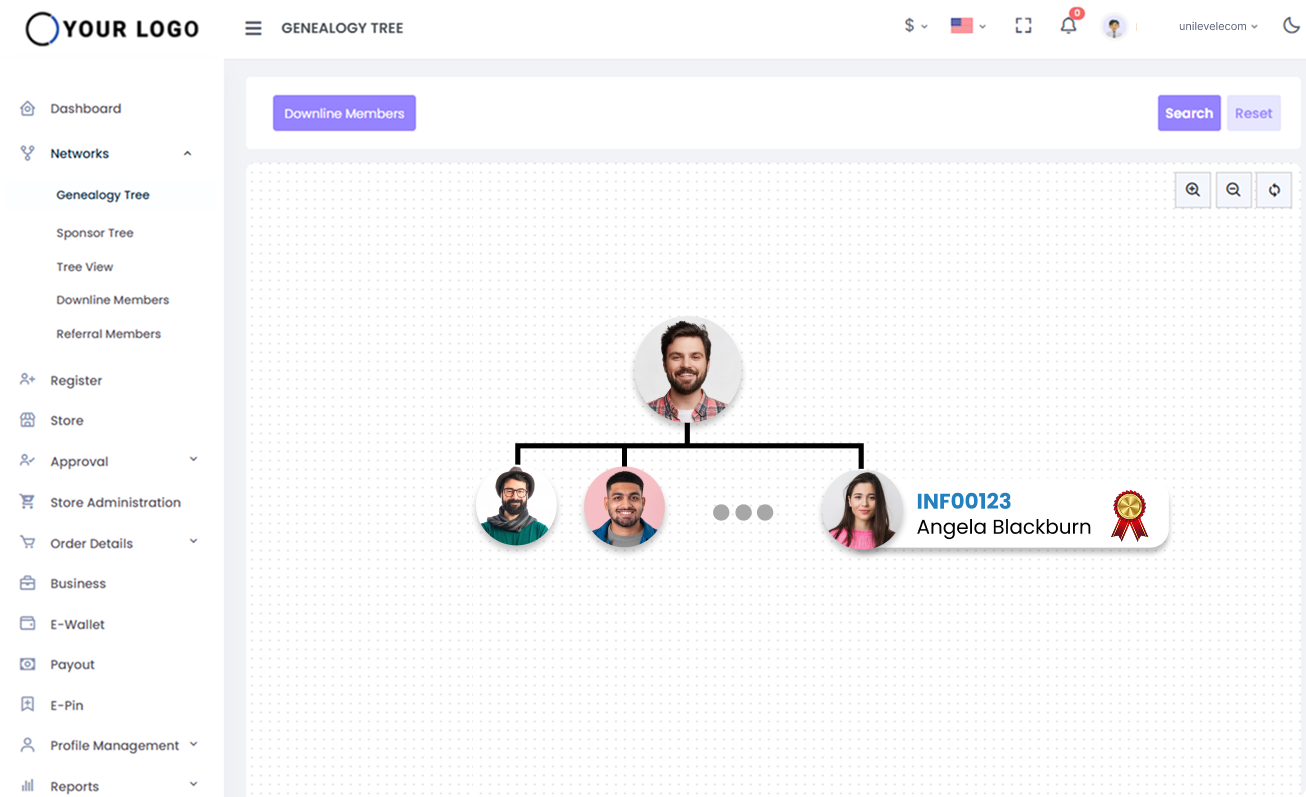
The unilevel genealogy tree is structured for maximum width, with each distributor allowed to sponsor an unlimited number of people on their first level. This means every personally sponsored individual is placed directly under the distributor, creating a wide and flat organizational structure.
Commissions in a unilevel plan are calculated as a percentage of the sales volume generated by distributors on the levels beneath you, usually up to a fixed number of levels. Higher ranks typically unlock deeper levels of commission earnings, rewarding both recruitment and ongoing team sales.
Commission processing and Unilevel MLM genealogy management are automated using Unilevel MLM Software, which simplifies the management of wide organizational structures.
Matrix Genealogy Tree
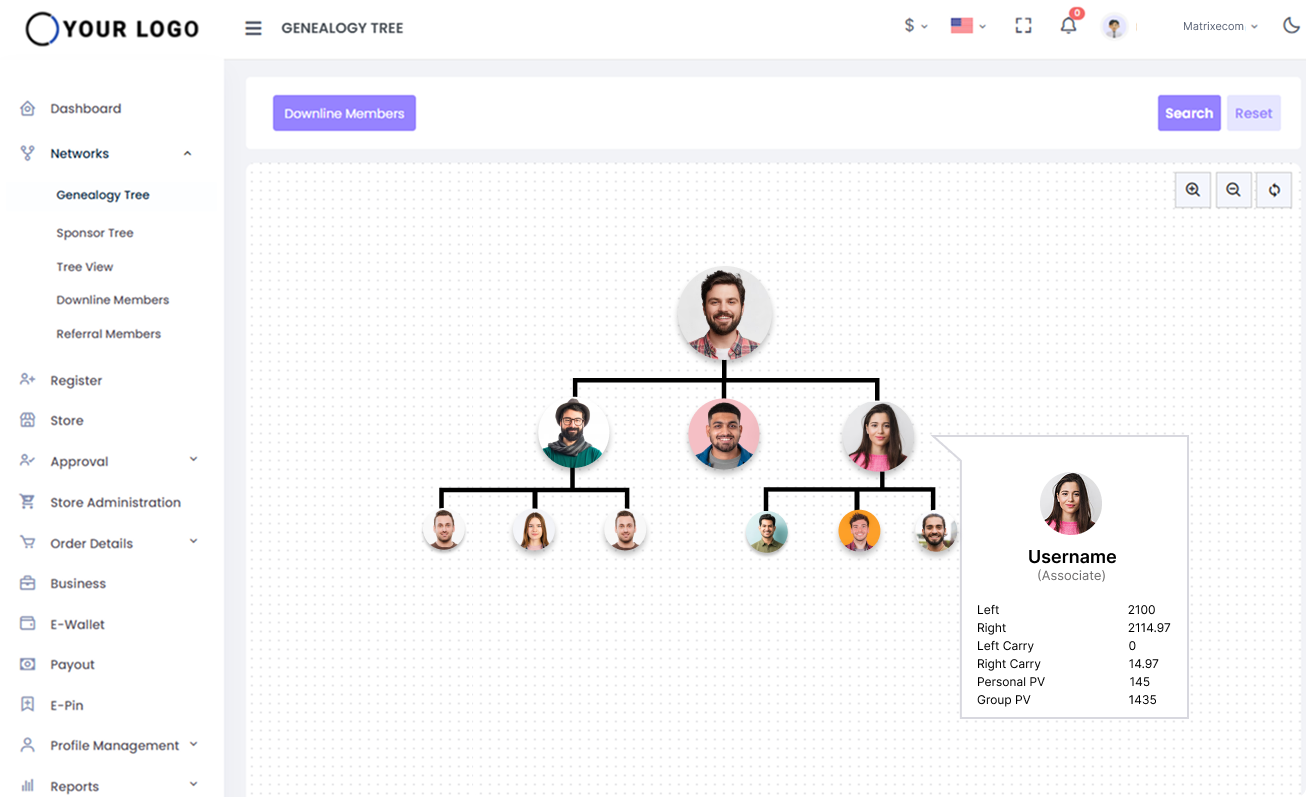
A matrix genealogy tree follows a fixed structure, limiting both the width and the depth of each distributor’s team. This means a distributor can only sponsor a certain number of people per level, and once that level is filled, additional recruits are automatically placed in the next available spot, creating spillover.
Commissions in a matrix plan are calculated based on the total sales volume generated within the fixed matrix positions. Distributors earn a percentage of sales from their personally sponsored recruits and spillover members within their matrix, often limited to a specific number of levels and positions.
The matrix plan rewards team synergy and structured growth, making it ideal for organizations where upline support is strong and where not every member is highly active in recruiting. Matrix MLM genealogy management is automated using Matrix MLM Software.
Breakaway Genealogy Tree

The breakaway genealogy tree starts with a unilevel structure, but it changes dynamically as key distributors reach leadership ranks. Once a downline distributor reaches a specified level of performance or rank, they “break away” to form their own team and operate as a separate business unit.
The original sponsor continues to earn override commissions based on the volume generated by these breakaway leaders and their teams.
This model emphasizes leadership development and rewards those who can train and mentor others to succeed independently. Commonly used by long-established MLM companies such as Amway, the breakaway plan is most effective for experienced network marketers who focus on building multiple strong leaders rather than just expanding width.
Hybrid Genealogy Tree
A hybrid genealogy tree combines elements from multiple MLM structures, such as binary and unilevel, to offer greater flexibility and earning potential.
For example, the system might use a binary tree for initial placement and team-building commissions, while applying a unilevel structure for long-term bonuses or leadership incentives.
This approach allows distributors to benefit from both depth and width, creating multiple income streams and opportunities to earn through personal sales, team volume, and leadership development.
Hybrid plans are often tailored to the specific goals of a company and are ideal for organizations seeking to motivate both individual performance and team collaboration.
Comparison of MLM Genealogy Types
| Type | Structure | Growth Style | Ideal For |
|---|---|---|---|
| Binary | 2 legs (left/right) | Deep with spillover | Team builders, spillover users |
| Unilevel | Unlimited width | Wide, based on recruitment | Strong recruiters |
| Matrix | Fixed width/depth | Balanced with spillover | Passive earners, team-dependent reps |
| Breakaway | Leadership-based | Depth via leadership tiers | Mentors and experienced leaders |
| Hybrid | Mixed (e.g., binary + unilevel) | Flexible and layered income | All-rounders and long-term builders |
The Key to Effective MLM Genealogy Management: MLM Software
Managing genealogy in a growing multi-level marketing business can become complex and time-consuming. As your team expands across multiple levels and regions, keeping track of who sponsored whom, downline activity, sales volume, and commission eligibility can quickly overwhelm manual systems. This is where MLM software becomes essential.
Here’s how MLM software supports effective genealogy management:
Automated Genealogy Tracking
MLM software automatically builds and updates the genealogy tree in real time as new distributors join. This ensures that every distributor is placed correctly according to the compensation plan and sponsorship rules, eliminating human error.
Visual Tree Representation
Most MLM platforms offer a graphical or tree-based view of the genealogy. This makes it easy for distributors and admins to understand team structure, spot gaps, track downlines, and identify key leaders at a glance.
Real-Time Downline Activity Monitoring
MLM software tracks and displays downline performance data such as Sales volume (personal and team), enrollment dates, rank progression, activation or inactivity status, allowing leaders to provide targeted support and identify opportunities for growth.
Commission and Bonus Calculation
The software uses genealogy data to accurately calculate commissions, overrides, bonuses, and rank qualifications based on your MLM’s unique compensation plan. This reduces administrative overhead and ensures timely and correct payments.
Spillover and Placement Control
MLM software plays a key role by automating placements according to predefined rules, providing options for manual overrides when necessary, and efficiently managing spillover to ensure the structure remains balanced and intact.
Reporting and Analytics
Detailed reports generated from the genealogy tree help distributors and corporate teams analyze downline growth trends, performance level, top performers and inactive segments to guide strategic decision-making and training efforts.
Secure Access and Role Management
MLM software can define who sees what. Distributors only view their own downlines, while corporate teams get full visibility across the entire organization protecting data privacy while enabling effective oversight.
Global Team Management
For MLMs operating in multiple countries, software ensures that global downlines are tracked in one integrated system, handling multi-currency, multi-language, and international MLM regulations and rules.
Features of a Good MLM Genealogy Software
A good MLM genealogy software is important for managing, visualizing, and analyzing the structure of a network marketing business. Below are key features that define an effective MLM genealogy software:
Genealogy Tree Visualization
An effective MLM genealogy software should provide an intuitive genealogy tree visualization. This includes support for different tree structures such as binary, unilevel, matrix, or hybrid plans.
Users should be able to explore their network using drag-and-drop navigation, zoom in or out for various levels of detail, and view members through color-coded indicators that show their level, rank, or activity status.
Downline Management
Efficient downline management is a core feature of any MLM genealogy software. It allows users to track their team members in real-time, view profiles with contact details, purchase history, and activity logs.
Users should be able to filter downline members by various attributes such as rank, country, status, or join date, making it easier to segment the network for targeted communications.
Note: To expand your network faster, you need a seamless way to activate new members in your genealogy tree. Integrating an MLM E-pin Management System allows for instant, secure enrollments. This eliminates payment delays and ensures your downline grows without interruption.
Commission Tracking
A good MLM genealogy software must handle complex commission tracking and payout structures accurately. It should automatically calculate earnings including direct sales commissions, team overrides, and performance bonuses based on the compensation plan used.
Users should have access to a detailed breakdown of their earnings history and real-time updates on commissions earned. Additionally, admins should be able to audit and adjust earnings manually if necessary, ensuring transparency and trust.
Performance & Rank Progress Tracking
Tracking performance and rank progression is essential for motivation and strategic planning. The Genealogy MLM software should offer visual indicators showing how close a distributor is to achieving the next rank, including the required metrics such as volume, new recruits, or team leg performance.
Dashboards that summarize overall team performance and display trends or comparisons over time help users identify strong performers and areas that need support. Alerts for near-rank advancements can prompt timely action and drive engagement.
Integration with E-commerce and CRM
For a great user experience, the Genealogy MLM software should integrate with the company’s e-commerce and customer relationship management (CRM) systems. This enables synchronization of product orders, autoship subscriptions, and user purchases with the genealogy tree and compensation system.
Integration with payment gateways like PayPal or Stripe ensures that transactions are processed smoothly. Moreover, CRM integration allows tracking of leads, follow-ups, and sales activities, empowering representatives to manage their business holistically.
Security & User Access Control
Security is critical in any system handling sensitive user and financial data. A good MLM genealogy platform must offer secure access control, allowing different roles such as admins, distributors, and customer support to have tiered access permissions.
Data should be encrypted, with secure login methods such as two-factor authentication (2FA) to prevent unauthorized access. In addition, maintaining detailed audit logs helps track changes and ensure compliance with internal and regulatory policies.
Mobile Optimization
Modern MLM users expect access to their business from anywhere, making mobile optimization a necessity. The software should be fully responsive on mobile devices and tablets, with a layout that adapts intuitively to smaller screens.
For added functionality and engagement, a dedicated mobile app is ideal, especially one that includes push notifications to inform users of new recruits, commissions, rank changes, or corporate announcements.
Customization and Scalability
Every MLM business has unique branding and structural requirements, so MLM genealogy software should be customizable and scalable. This includes the ability to tailor the visual design (e.g., logo, color scheme), adjust tree structures or compensation parameters, and add or remove features based on business needs.
As the company grows, the software should be able to support a growing number of users and deeper network structures without performance loss or the need for platform migration.
Real-Time Updates
Real-time functionality ensures that users always have the latest data on their network’s performance. Whether it’s a new sign-up, a commission update, or a team member advancing in rank, these updates should be reflected instantly across all devices.
This real-time feedback helps users make quicker decisions, respond to opportunities, and maintain a more active and engaged team. Eliminating the need for manual refreshes improves user experience and system reliability.
Admin & Support Tools
Finally, strong admin and support tools are essential for smooth operations. Administrators should have access to a backend dashboard for overseeing the entire network, managing user accounts, and resolving issues. Tools for troubleshooting, such as identifying orphaned nodes or duplicate entries, help maintain data integrity.
Bulk action capabilities like reassigning downlines or updating member info saves time and reduces manual errors. A built-in support ticket system or live chat can further improve user satisfaction and reduce churn.
Track downlines in real-time, visualize your team structure, and spot top performers or weak spots instantly with MLM genealogy software.
Conclusion
MLM genealogy is much more than a simple visual chart. It serves as the foundation for effective team management, strategic growth, and precise commission tracking in network marketing. Regardless of whether your business follows a binary, unilevel, matrix, breakaway, or hybrid model, a well-organized genealogy tree provides the visibility and structure needed to build, support, and scale your organization.
By integrating advanced MLM software, this process becomes even more powerful. It automates complex tasks, delivers real-time insights, and supports scalable, secure, and global management, giving you the tools to lead your network with confidence and efficiency.
Frequently Asked Questions
Genealogy refers to the full visual and structural map of how distributors are connected through sponsorship and placement. Downline refers specifically to the people you’ve recruited (directly or indirectly) under you in the network. The downline is part of the genealogy, but genealogy includes placement details, volume and rank status as well.
An MLM genealogy tree typically shows:
-
Distributor name or ID
-
Enrollment/sponsor/upline details
-
Rank and level
-
Personal and team sales volumes (PSV, GV)
-
Downline size and structure
-
Rank progress and commission eligibility
-
Activity status (active, inactive, pending)
Binary trees are popular because they:
-
Encourage team cooperation through spillover
-
Are easy to understand (two legs: left and right)
-
Provide quick rank advancement opportunities
-
Promote balanced team-building for maximum payouts
Yes. Most modern MLM genealogy software allows customization for binary, unilevel, matrix, breakaway, or hybrid plans. You can also adjust visuals, filters, and displayed metrics based on your compensation structure.
Spillover occurs when a sponsor places new recruits below existing downline members because their personal placement limit has been reached (common in binary or matrix plans). This can benefit team members who may receive additional support without recruiting directly.
Genealogy trees show who sponsored whom and where each sale occurred, making it easy to calculate who qualifies for commissions, overrides, or bonuses based on the downline’s activity and placement.
-
Sponsor: The person who recruited a new distributor.
-
Placement: The actual position where the distributor appears in the genealogy tree.
In some plans, a sponsor may choose to place recruits under other team members to strengthen weak legs or help others qualify for bonuses.
Yes. Good MLM software supports multi-country teams with features like multi-currency, regional compensation rules, and language support. The global genealogy can be viewed as one connected network.

